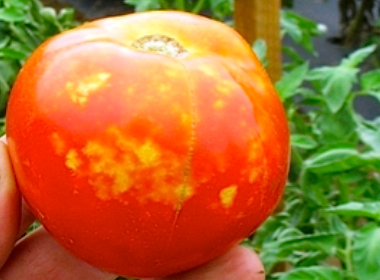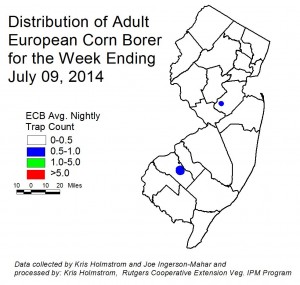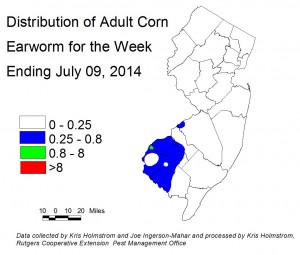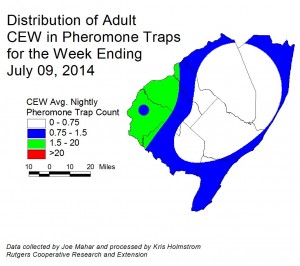Vegetable IPM Report 7-9-14 – Click to View | Download | Print
Maps for the Week
–European Corn Borer Map
–Corn Earworm Moth Blacklight Trap Map
–Corn Earworm Moth Pheromone Trap MapTopics for the Week
- Sweet Corn
- Peppers
- Pepper Weevil Report
- Tomatoes
- BMSB
- Pumpkins and Winter Squash
Sweet Corn
European Corn Borer (ECB) adult catches remain very low, as we are between flights. At this time, very limited catches are occurring randomly throughout the state, with slightly more consistent catches in parts of Gloucester and Middlesex County (see ECB map). Larval infestations in sweet corn have peaked in corn plantings, and plants now entering whorl stage are largely free of ECB damage. Some infestations remain in pre-tassel stage corn.
Consider treating if 12% or more plants exhibit the characteristic “shot-hole” type feeding on leaves. As plants mature to pre-tassel, live larvae and droppings can be observed in the tassels. Remember to make a full-tassel application to control ECB larvae as they leave the tassel and travel down the stalk to re-enter the plant near the ear shank. This last application is often critical to controlling ear infestations from ECB. Often, early sweet corn plantings suffer from “split set”, in which germination does not occur in a uniform fashion. The result is a planting where all plants do not reach full tassel at the same time. This situation may require an extra tassel spray if there are several days difference in the time full tassel is reached on a significant number of the plants.
| The highest nightly ECB catches for the previous week are as follows: | |||||
| Belvidere | 1 | Eldora | 1 | Port Colden | 1 |
| Cinnaminson | 1 | Jones Island | 1 | RAREC | 1 |
| Clinton | 1 | Medford | 1 | Tabernacle | 1 |
| Downer | 1 | Pedricktown | 1 | Woodstown | 1 |
Blacklight Trap Corn Earworm Moth (CEW): Corn earworm moths (CEW) have been captured with increasing frequency in blacklight traps from southwestern Burlington County south through Cumberland County this past week. It is possible that last weeks’ tropical system assisted some CEW migration into this area, but we would expect gradual increases in adults now until the major migratory push that typically comes in August.
| The highest nightly CEW trap catches are as follows: | |||||
| Pedricktown | 2 | Folsom | 1 | RAREC | 1 |
| Centerton | 1 | Green Creek | 1 | Tabernacle | 1 |
| Cinnaminson | 1 | Jones Island | 1 | ||
| Downer | 1 | Medford | 1 | ||
Pheromone Trap Corn Earworm Moth (CEW): Catches have shifted to the west in pheromone traps in the southern counties (see CEW pheromone trap map). The blue area on the map roughly corresponds to a 5-6-day silk spray schedule, and green areas to a 4-day schedule, although the relatively few number of pheromone traps results in a broad blue area which does not reflect local differences. Blacklight and pheromone traps match in terms of where most moth activity is occurring. Highest activity is along the Delaware Bay shore. Sweet corn plantings now in silk in southern NJ are at risk for ear infestation if CEW is not properly controlled. As silks begin to appear, pay close attention to CEW catches in local blacklight traps, and treat silking plantings accordingly.
| The highest nightly CEW pheromone trap catches are as follows: | |||||
| Pedricktown | 6 | Springdale | 2 | ||
| Beckett | 2 | Woodstown | 2 | ||
| Green Creek | 2 | ||||
Silking Spray Schedules*:
South – 4-5 days
Central – 6 days
North – 6-7 days
*Note: These are general recommendations. Local trap catches may indicate some variation in the frequency of insecticide applications to silking corn.
Fall armyworm (FAW) infestations have been increasing steadily, particularly in coastal areas. Whorl stage infestations above 12% are common now as far north as coastal Monmouth County. FAW caterpillars consume corn foliage, and produce large quantities of feces that pile up within the whorl. FAW larvae typically have light and dark brown bands, and the head capsule has a distinctive upside-down “Y” pattern on it. Unlike ECB, FAW will feed on corn plantings in the seedling stage, although whorl stage is usually the first to be affected. Consider treating if the number of plants infested with FAW either alone, or in combination with ECB exceeds 12%. FAW may be difficult to control with pyrethroid insecticides. Newer materials, including spinosad-based insecticides, as well as those including active ingredients chlorantraniliprole and flubendiamide are effective against BAW.
Peppers
Pepper plantings are developing two spotted spider mite (TSSM) infestations in many areas. With warm, humid conditions TSSM can build to high populations rapidly. The use of pyrethroid insecticides for worm control may encourage the development and severity of TSSM problems in peppers. Infestations will be most easily detected by the whitish “pin-spot” or stipple that appears on the upper leaf surface as TSSM feed below. TSSM infestations may develop near other favored hosts like watermelon and eggplant, or near field edges as bordering vegetation dries up or is mowed. Many effective miticides are available. See the 2014 Commercial Vegetable Production Recommendations for materials useful in controlling TSSM. If caterpillar pests warrant control, consider an insecticide that is not destructive to predators and parasites of aphids and TSSM. These include Coragen and Belt (or Synapse).
Joe Ingerson-Mahar reports that beet armyworm (BAW) have been found in Cape May County. This pest has, unusually, shown up in sweet corn, but is predominantly a pepper pest. As pepper infestations occur, information will follow.
Pepper Weevil Report
Pepper weevil counts in the traps remain at zero, following the pattern of last year. No reported field infestations at this time. This doesn’t mean that they won’t reappear later in the season. However, for now, no weevils is good news. There is no map for this week.
Tomatoes
Colorado potato beetle (CPB) feeding has been occurring for the past few weeks, and activity has recently reached the northern counties. Be sure to inspect fields at least weekly for the presence of adults and larvae. Field inspections should include areas adjacent to last years’ host crop (eggplant, potato and tomato, as well as the perennial weed, horsenettle). If infestations are localized it may be possible to spot treat. Remember that if a neonicotinoid insecticide (imadicloprid or related material) was used at planting, it is not advisable to use a similar product as a foliar spray, as this may hasten resistance in the local CPB population. See the 2014 Commercial Vegetable Production Recommendations for materials useful in controlling CPB.
Field scouts are beginning to see native brown stinkbugs in a number of crops. Early July is typically the time of summer when adults become active in host crops, and damage may be expected. Native species have a distinct preference for tomatoes. Typically this injury increases with drier weather. Be sure to monitor fruit for this damage (known as cloudy spot – see photo). If cloudy spot is increasing in harvested fruit, consider an insecticide application to limit further damage. Consult the 2014 Commercial Vegetable Production Recommendations for specific insecticide recommendations.

“Cloudy Spot” native brown stinkbug damage on tomato.
Photo: Jerry Brust, IPM Vegetable Specialist, UMd
Recent reports of Late Blight (LB) from New York and Pennsylvania serve as warning that growers should scout fields several times a week. Recent hot weather has not been favorable for the development of late blight in our area. Protectant fungicides used to manage early blight, septoria and anthracnose will offer some protection against late blight, but should LB appear in our area, systemic fungicides would also be necessary. LB infected foliage collapses rapidly, with leaves and petioles appearing to have been “crushed”. At the margins of the infection, a whitish haze of spores may be visible. This sporulation appears similar to powdery mildew, but infected tissue nearby will be much more heavily damaged than would be the case from a powdery mildew infection. As infected leaves collapse, they often remain dark green rather than turning dry and brown, as with early blight.
Brown Marmorated Stinkbug (BMSB)
BMSB activity has increased slightly, but catches remain quite low overall in blacklight traps. Adult activity continues to be well behind in 2014. As adult captures increase to 5/night for a full week, maps will be produced to show where activity is highest. Information on scouting, crop injury and control will also be included.
| At present, the highest nightly BMSB catches are as follows: | |||||
| RAREC | 5 | Flanders | 1 | Phillipsburg | 1 |
| Woodstown | 2 | Green Creek | 1 | Jones Island | 1 |
| Centerton | 1 | East Vineland | 1 | Pedricktown | 1 |
Pumpkins and Winter Squash
These crops are beginning to run in many areas. Cucumber beetles are much less of a threat to these larger plants, and insecticides are rarely necessary. It is important to limit the use of broad spectrum insecticides at this time, as bees are actively pollenating flowers. As fruit begin to appear and enlarge, the appearance of powdery mildew (PM) will follow. Until PM lesions develop, there is no need for fungicides targeting that pathogen. Check upper and lower surfaces of 2 mature leaves per plant on 5 consecutive plants each, in 10 locations throughout the field. When PM lesions are found on 2 or more leaves, begin a weekly protectant fungicide program. See the 2014 Commercial Vegetable Production Recommendations for materials useful in managing PM.
A sentinel plot containing susceptible and resistant cucumber varieties, as well as muskmelons, watermelons, acorn and butternut squash and pumpkins is now established at the Snyder Research and Extension Farm in Hunterdon County and another will be established at RAREC in mid-July. The purpose of these plots is to detect the presence of downy mildew (DM) in northern NJ. Vines are beginning to run, and no DM has been observed in the plot. Any occurrence will be reported in this newsletter and will also generate an alert to all subscribers. For more information on the regional presence of DM as well as comprehensive, weekly forecasts, see the following website: http://cdm.ipmpipe.org/
All current and archived Vegetable IPM Maps including European corn borer, corn earworm and brown marmorated stink bug population maps are available for viewing @
http://tinyurl.com/njaes-ipm-maps




